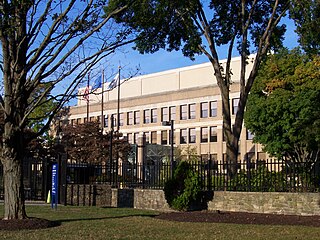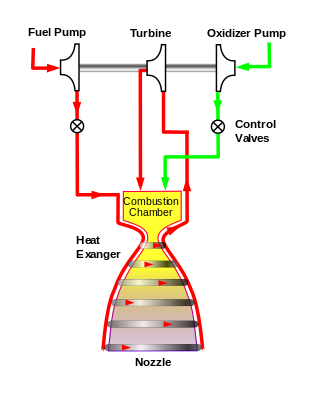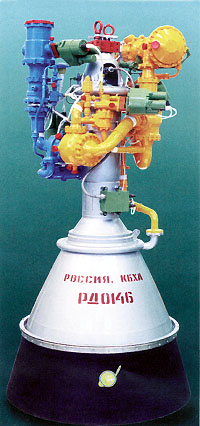
Pratt & Whitney is an American aerospace manufacturer with global service operations. It is a subsidiary of RTX Corporation. Pratt & Whitney's aircraft engines are widely used in both civil aviation and military aviation. Its headquarters are in East Hartford, Connecticut. The company is the world's second largest commercial aircraft engine manufacturer, with a 35% market share as of 2020. In addition to aircraft engines, Pratt & Whitney manufactures gas turbine engines for industrial use, marine propulsion, and power generation. In 2017, the company reported that it supported more than 11,000 customers in 180 countries around the world.

The expander cycle is a power cycle of a bipropellant rocket engine. In this cycle, the fuel is used to cool the engine's combustion chamber, picking up heat and changing phase. The now heated and gaseous fuel then powers the turbine that drives the engine's fuel and oxidizer pumps before being injected into the combustion chamber and burned.

Rocketdyne was an American rocket engine design and production company headquartered in Canoga Park, in the western San Fernando Valley of suburban Los Angeles, in southern California.

The Space Shuttle Solid Rocket Booster (SRB) was the first solid-propellant rocket to be used for primary propulsion on a vehicle used for human spaceflight. A pair of these provided 85% of the Space Shuttle's thrust at liftoff and for the first two minutes of ascent. After burnout, they were jettisoned and parachuted into the Atlantic Ocean where they were recovered, examined, refurbished, and reused.

The Aerojet Rocketdyne RS-25, also known as the Space Shuttle Main Engine (SSME), is a liquid-fuel cryogenic rocket engine that was used on NASA's Space Shuttle and is currently used on the Space Launch System (SLS).

The John C. Stennis Space Center (SSC) is a NASA rocket testing facility in Hancock County, Mississippi, United States, on the banks of the Pearl River at the Mississippi–Louisiana border. As of 2012, it is NASA's largest rocket engine test facility. There are over 50 local, state, national, international, private, and public companies and agencies using SSC for their rocket testing facilities.

The F-1, commonly known as Rocketdyne F-1, is a rocket engine developed by Rocketdyne. This engine uses a gas-generator cycle developed in the United States in the late 1950s and was used in the Saturn V rocket in the 1960s and early 1970s. Five F-1 engines were used in the S-IC first stage of each Saturn V, which served as the main launch vehicle of the Apollo program. The F-1 remains the most powerful single combustion chamber liquid-propellant rocket engine ever developed.

The J-2, commonly known as Rocketdyne J-2, was a liquid-fuel cryogenic rocket engine used on NASA's Saturn IB and Saturn V launch vehicles. Built in the United States by Rocketdyne, the J-2 burned cryogenic liquid hydrogen (LH2) and liquid oxygen (LOX) propellants, with each engine producing 1,033.1 kN (232,250 lbf) of thrust in vacuum. The engine's preliminary design dates back to recommendations of the 1959 Silverstein Committee. Rocketdyne won approval to develop the J-2 in June 1960 and the first flight, AS-201, occurred on 26 February 1966. The J-2 underwent several minor upgrades over its operational history to improve the engine's performance, with two major upgrade programs, the de Laval nozzle-type J-2S and aerospike-type J-2T, which were cancelled after the conclusion of the Apollo program.

The Rocketdyne H-1 was a 205,000 lbf (910 kN) thrust liquid-propellant rocket engine burning LOX and RP-1. The H-1 was developed for use in the S-I and S-IB first stages of the Saturn I and Saturn IB rockets, respectively, where it was used in clusters of eight engines. After the Apollo program, surplus H-1 engines were rebranded and reworked as the Rocketdyne RS-27 engine with first usage on the Delta 2000 series in 1974. RS-27 engines continued to be used up until 1992 when the first version of the Delta II, Delta 6000, was retired. The RS-27A variant, boasting slightly upgraded performance, was also used on the later Delta II and Delta III rockets, with the former flying until 2018.

The RL10 is a liquid-fuel cryogenic rocket engine built in the United States by Aerojet Rocketdyne that burns cryogenic liquid hydrogen and liquid oxygen propellants. Modern versions produce up to 110 kN (24,729 lbf) of thrust per engine in vacuum. Three RL10 versions are in production for the Centaur upper stage of the Atlas V and the DCSS of the Delta IV. Three more versions are in development for the Exploration Upper Stage of the Space Launch System and the Centaur V of the Vulcan rocket.

Aerojet Rocketdyne is a subsidiary of American defense company L3Harris Technologies that manufactures rocket, hypersonic, and electric propulsive systems for space, defense, civil and commercial applications. Aerojet traces its origins to the General Tire and Rubber Company established in 1915, while Rocketdyne was created as a division of North American Aviation in 1955. Aerojet Rocketdyne was formed in 2013 when Aerojet and Pratt & Whitney Rocketdyne were merged, following the latter's acquisition by GenCorp from Pratt & Whitney. On April 27, 2015, the name of the holding company, GenCorp Inc., was changed to Aerojet Rocketdyne Holdings, Inc. Aerojet Rocketdyne Holdings was acquired by L3Harris in July 2023 for $4.7 billion.

The Aerojet Rocketdyne RS-68 is a liquid-fuel rocket engine that uses liquid hydrogen (LH2) and liquid oxygen (LOX) as propellants in a gas-generator power cycle. It is the largest hydrogen-fueled rocket engine ever flown.
The integrated powerhead demonstrator (IPD) was a U.S. Air Force project in the 1990s and early 2000s run by NASA and the Air Force Research Laboratory (AFRL) to develop a new rocket engine front-end that would utilize a full flow staged combustion cycle (FFSCC). The prime contractors were Rocketdyne and Aerojet.
The Earth Departure Stage (EDS) is the name given to the proposed second stage of the Block 2 Space Launch System. The EDS is intended to boost the rocket's payload into a parking orbit around the Earth and from there send the payload out of low Earth orbit to its destination in a manner similar to that of the S-IVB rocket stage used on the Saturn V rockets that propelled the Apollo spacecraft to the Moon. Its development has been put on hold until stages capable of transferring heavy payloads to Mars are required.

Ares I was the crew launch vehicle that was being developed by NASA as part of the Constellation program. The name "Ares" refers to the Greek deity Ares, who is identified with the Roman god Mars. Ares I was originally known as the "Crew Launch Vehicle" (CLV).

DIRECT was a late-2000s proposed alternative super heavy lift launch vehicle architecture supporting NASA's Vision for Space Exploration that would replace the space agency's planned Ares I and Ares V rockets with a family of Shuttle-Derived Launch Vehicles named "Jupiter". It was intended to be the alternative to the Ares I and Ares V rockets which were under development for the Constellation program, intended to develop the Orion spacecraft for use in Earth orbit, the Moon, and Mars.

The RD-0146 (РД-0146) is a liquid-fuel cryogenic rocket engine developed by KBKhA Kosberg in Voronezh, Russia.

Pratt & Whitney Rocketdyne (PWR) was an American company that designed and produced rocket engines that use liquid propellants. It was a division of Pratt & Whitney, a fully owned subsidiary of United Technologies Corporation. It was headquartered in Canoga Park, Los Angeles, California. In 2013, the company was sold to GenCorp, becoming part of Aerojet Rocketdyne.

The ascent propulsion system (APS) or lunar module ascent engine (LMAE) is a fixed-thrust hypergolic rocket engine developed by Bell Aerosystems for use in the Apollo Lunar Module ascent stage. It used Aerozine 50 fuel, and N
2O
4 oxidizer. Rocketdyne provided the injector system, at the request of NASA, when Bell could not solve combustion instability problems.
The MARC-60, also known as MB-60, MB-XX, and RS-73, is a liquid-fuel cryogenic rocket engine designed as a collaborative effort by Japan's Mitsubishi Heavy Industries and US' Aerojet Rocketdyne. The engine burns cryogenic liquid oxygen and liquid hydrogen in an open expander cycle, driving the turbopumps with waste heat from the main combustion process.























